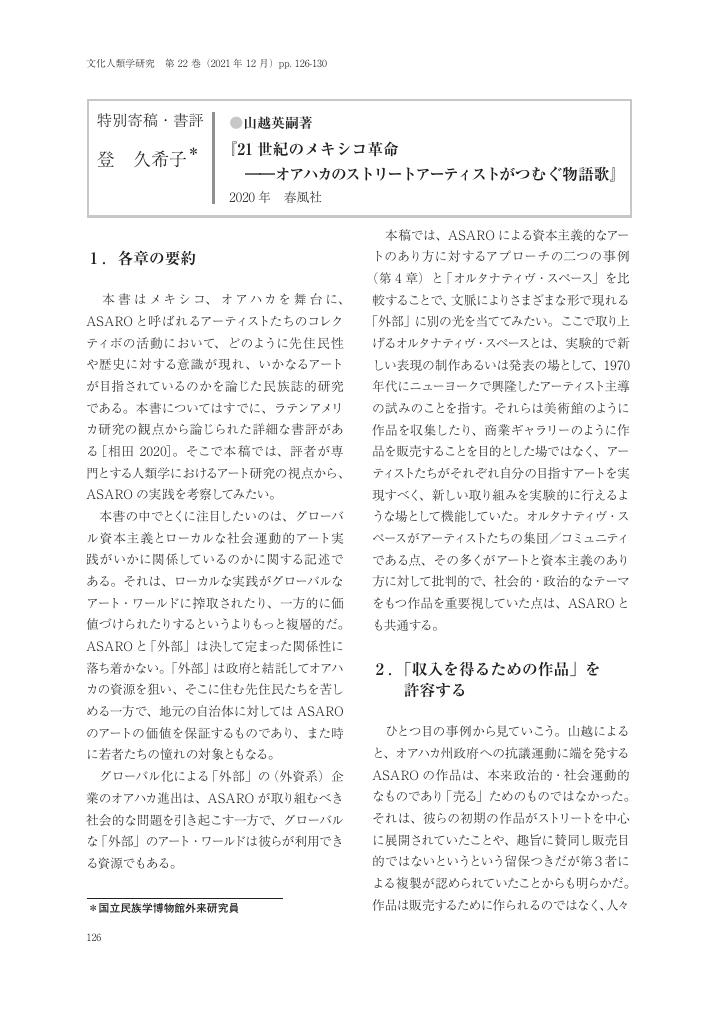16 0 0 0 OA 「文化戦争」と芸術の自由
- 著者
- 登 久希子
- 出版者
- カルチュラル・スタディーズ学会
- 雑誌
- 年報カルチュラル・スタディーズ (ISSN:21879222)
- 巻号頁・発行日
- vol.5, pp.119, 2017 (Released:2019-10-09)
- 参考文献数
- 24
1980 年代後半から1990 年代にかけて、文化の多様性が顕在化するアメリカにおいて「ア メリカ的」価値観を巡る社会的かつ政治的な対立としての「文化戦争(Culture Wars)」が激 化した。本稿はそこでいかなる芸術の自由が求められたのか、そして特定の作品を巡って 何が実際に争われていたのかを考察するものである。芸術分野における文化戦争の発端は 一般的にアンドレ・セラーノとロバート・メイプルソープの作品にさかのぼる。当時、ア メリカの国立機関である全米芸術基金(NEA)は存続の危機にあった。その撤廃を目論む 共和党保守派の政治家たちは宗教右派団体による「冒涜的」な作品の批判を利用し、それ らの作品を支援するNEA を攻撃した。 本稿では文化戦争において保守派の批判を受けた作品について、多様な性的アイデンテ ィティの表象だけではなく、資本主義経済における「もの」の分類が問題となっていた点 を明らかにする。そこで求められる芸術の自由は、ものの存在のあり方にも関わる。まず 第1 節において、メイプルソープの展覧会取りやめとそれに対する抗議行動でみられたふ たつの芸術の自由の言説について考察し、一方が芸術という自律した領域を前提とするも のであり、もう一方は社会に根ざした一市民としてアーティストが持つべき表現の自由を 前提としていた点を確認する。つづいて、セクシュアリティや暴力をテーマにしたパフォ ーマンス・アートを手がけてきたカレン・フィンリーの事例において、個人による表現の 自由の言説がより強調されていく様を追い、フィンリーが公的助成金と芸術の「自由」を どのように関係づけていたのかを確認する。文化戦争において争われた芸術の自由とは主 体の権利としてだけではなく資本主義経済における「もの」の分類をめぐって展開された のだ。
- 著者
- 登 久希子
- 出版者
- 日本文化人類学会
- 雑誌
- 文化人類学 (ISSN:13490648)
- 巻号頁・発行日
- vol.76, no.2, pp.171-181, 2011-09-30
This paper considers the method of studying contemporary art from an anthropological viewpoint, focusing on the case of making installation art. In contrast to previous institutional studies, which focus on the modern Western system of art as the "art world" and the "art-culture system," it considers the making of art ethnographically following the interaction between human and non-human actors. In the field of contemporary art, such as galleries and art centers, an ordinary object hardly ever transforms suddenly into an object to be admired as a work of art. Becoming art is regarded, rather, as a gradual process. To study art in the making enables us to see the works of contemporary art not only as the result of a status elevation within the system of art, but also as a bundle of relationships formed through the process of the mutual transformation of human and non-human actors. Both Acord [2010] and Yaneva [2003] study the making of installation art and the installation of art referring to the Actor Network Theory. Their studies make it clear that artworks and exhibitions are generated through the continual interaction between human and non-human actors, including curators, artists, and the various materials found in museum settings. As Yaneva suggests, it is important to see artists not as sole creative actors but as the vehicles of other participants' agency [Yaneva 2003b: 178]. However, in the making of installation art, the discourses and practices of creativity are often more complex than Yaneva and Acord describe. The art historian, Claire Bishop, points out the "fine line" between installation art and the installation of art. On one hand, she says that installation art is made up of "the ensemble of elements within it" and regarded as a "singular totality," while the installation of art is "secondary in importance to the individual works it contains" [Bishop 2005:6]. Bishop indicates that the line has been ambiguously drawn by the actors dealing with contemporary art. That relates to discussions about the "creativity" of curators, who are often recognized as the authors of exhibitions, and even occupy the status of quasi-artists in the field of contemporary art. Although neither Acord nor Yaneva decipher a particular difference between them, that very ambiguity results from the nature of contemporary art, which should be carefully examined. By comparing those ethnographic studies, this paper uncovers the need to reconsider the lines drawn between artists and curators, as well as installation art and the installation of art, which blur the field of contemporary art by following actors to see how they separate and obscure the source of "creativity."
- 著者
- 登 久希子
- 出版者
- 現代文化人類学会
- 雑誌
- 文化人類学研究 (ISSN:1346132X)
- 巻号頁・発行日
- vol.22, pp.126-130, 2021 (Released:2022-01-29)
- 参考文献数
- 3
1 0 0 0 OA 現代美術の境界的領域 社会性を志向するアートについての一考察
- 著者
- 登 久希子
- 出版者
- 日本文化人類学会
- 雑誌
- 日本文化人類学会研究大会発表要旨集 日本文化人類学会第52回研究大会 (ISSN:21897964)
- 巻号頁・発行日
- pp.78, 2018 (Released:2018-05-22)
本発表は2000年代初頭から現代美術の文脈で注目をあつめてきた「ソーシャリー・エンゲイジド・アート」や「ソーシャル・プラクティス」と呼ばれるような「社会性」を指向する芸術実践を事例に、芸術と非芸術としての日常生活(life)のあいだにいかなる《境界的領域》が生起し得るのかを人類学的に考察するものである。
- 著者
- 登 久希子
- 出版者
- 美術出版社
- 雑誌
- アートマネジメント研究
- 巻号頁・発行日
- no.14, pp.29-39, 2013
1 0 0 0 OA 現代美術の実践におけるエージェンシーのあり方
- 著者
- 登 久希子
- 出版者
- 日本文化人類学会
- 雑誌
- 日本文化人類学会研究大会発表要旨集 日本文化人類学会第50回研究大会 (ISSN:21897964)
- 巻号頁・発行日
- pp.I02, 2016 (Released:2016-04-23)
本発表は、現代美術におけるエージェンシーのあり方について、「関係性の美学(relational aesthetics)」として注目されてきた実践と「オルタナティヴ・スペース」の取り組みを事例に再考するものである。
